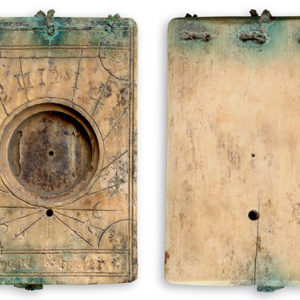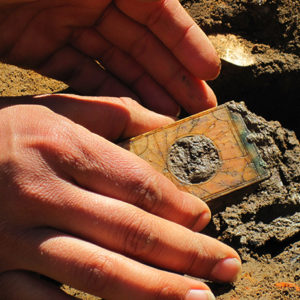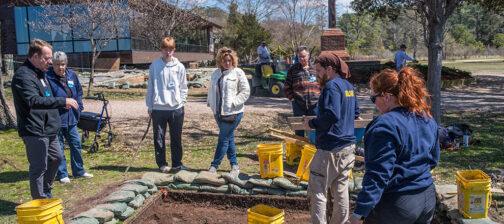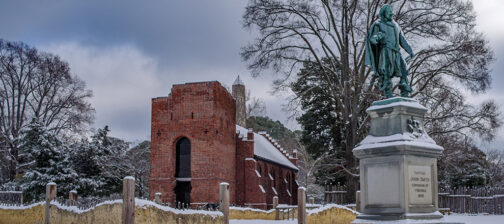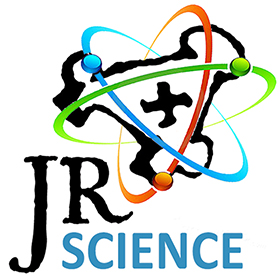 So far the most spectacular find of the 19th archaeological season at Historic Jamestowne is the lower leaf of an ivory pocket sundial known as a diptych dial. Made in Nuremberg, Germany, the dial bears the name of Hans Miller, who is known to have been crafting these objects in the early 17th century.
So far the most spectacular find of the 19th archaeological season at Historic Jamestowne is the lower leaf of an ivory pocket sundial known as a diptych dial. Made in Nuremberg, Germany, the dial bears the name of Hans Miller, who is known to have been crafting these objects in the early 17th century.
The dial came out of fill above a cellar from the early James Fort period (1607-1610). This feature is in an area west of the brick church tower and north of the 1608 church showcased in the 2011 excavations. This cellar aligns with James Fort’s first well, which sits just 10 feet away to the west and at the same angle.
The lower leaf of the diptych dial is similar to the lower leaf of a table dial recovered in 1998 from the “Factory” structure just outside the eastern palisade of James Fort. Such a tool may have been in common use in the 17th century among English gentlemen, but they are rare archaeological finds.
Such dials have two leaves like a book, hinged together on one end so the leaves open out to form a right angle. Most diptych dials include a horizontal dial engraved on the inside of the lower leaf and a vertical dial on the inside of the upper. Strung between the two leaves is a “pole string” to serve as the gnomon (the object that makes a shadow; measuring the length and position of that shadow indicates the hour of the day).
Engraved on the inner surface of the dial found in 1998 are the daylight hour lines of 6 a.m. through noon, with the digits in Roman numerals and with dots marking the half-hours. The numbers may have been colored with a red pigment, probably cinnabar. The dial surrounds a recess that would have held the magnetic compass that made sure the gnomon was properly aligned. The gnomon is now missing but would have been attached to the lower leaf by being knotted through a hole that is visible passing through to the back.
What was the main purpose of the diptych? The most accurate of these instruments could provide local time, but what was the pressing social or economic need to tell time in a 17th-century military outpost? Jamestown Rediscovery Senior Archaeological Curator Bly Straube believes that more important was the aesthetic or religious satisfaction from making a device to simulate the heavens.
Captain John Smith once used a “round Ivory double compass Dyall” to stall for time when he was captured by Indians. His exploring party had retreated in the group’s one boat back to James Fort. Smith was now stranded with one Indian guide, deep in a “vast and wilde wilderness” in December 1607. Smith bound his Indian guide to his arm as a human shield and proceeded through the swampy headwaters of the Chickahominy River, but the pair was quickly surrounded by 200 Pamunkey hunters.
After a brief struggle, they took Smith to Opechancanough, brother of the leader of 15,000 Indians in eastern Virginia. Smith claimed he was bound to a tree as the Indians prepared to kill him, but Openchancanough decided to spare Smith’s life: “Holding up the Compass in his hand, they all laid downe their Bowes and Arrowes.” Smith said they “marvailed at the playing of the Fly and Needle, which they could see so plainely, and yet not touch it, because of the glass that covered them.” Smith also illustrated his own culture’s belief in a universe that operates with clockwork predictability: “he demonstrated by that Globe-like Jewell, the roundnesse of the earth, and skies, the spheare of the Sunne, Moone, and Starres, and how the Sunne did chase the night round about the world continually; the greatnesse of the land and Sea, the diversity of nations, varietie of complexions, and how we were to them antipodes, and many other such like matters, they all stood as amazed with admiration.”
The Powhatans were indeed antipodes to the English. Not only did they occupy opposite positions on the round earth, but they were also a world apart in their ideologies and the imperialistic energies that brought the two groups together. Opechancanough would have been skeptical of the science lesson spoken in English: his people believed firmly in a flat earth. Even Smith came to understand this: “They imagined the world to be flat and round like a trencher [platter], and they in the middest.”
After his science lesson, Smith was taken to a village and treated to the feasting and dancing and audience with Indian leaders usually given to important guests in Powhatan culture (he was even allowed to use his own notebook to write a letter back to James Fort). When Smith was later taken to meet Powhatan in his capital village, the Indian leader was indeed fascinated by the compass. Smith’s astronomical performance helped established him in the Indians’ eyes as someone who could use a special tool to connect to the universe beyond their homelands.
The presence of these dials at Jamestown represents the age in which they were produced—an age of exploration and discovery that was as much about philosophy as it was science. The “compass Dyall” was more than a timekeeper to the 17th century individual; it was a way for a gentleman engaged in the art of “dyalling” to ponder his place in the world.
related images
- Such dials had two leaves like a book, hinged together on one end so the leaves opened out to form a right angle.
- The arrow in this photo points to where the dial was found in April in the L-shaped footprint of the early James Fort cellar.
- Slate Sundial Reverse
- Willie Balderson, portraying original Jamestown settler Anas Todkill, demonstrates how to read the pocket sundial.



